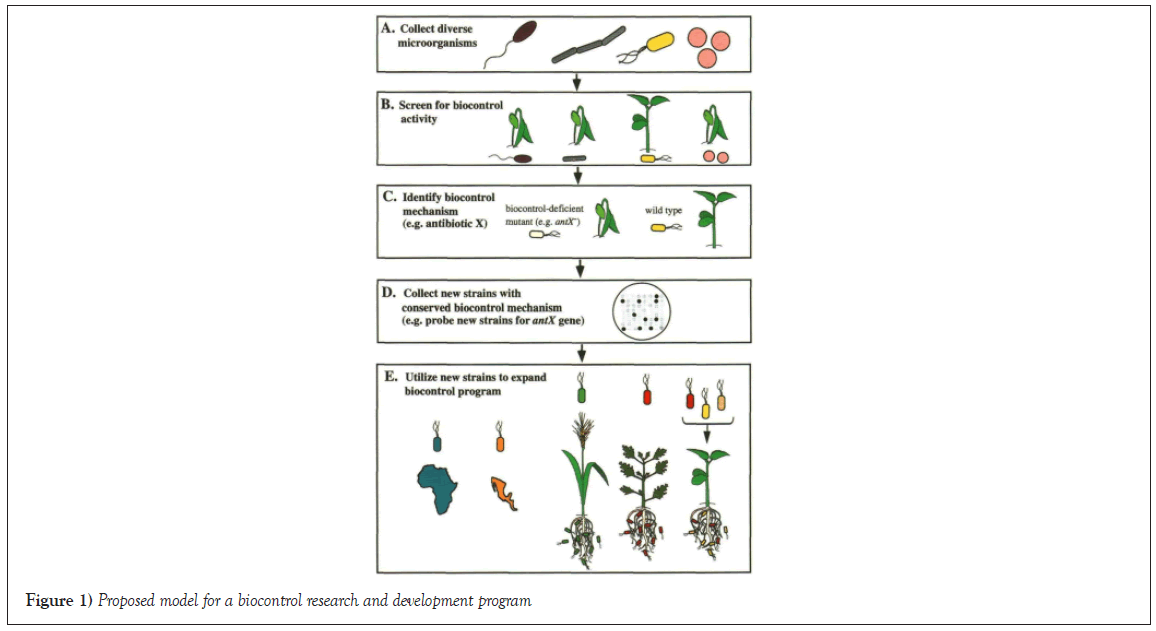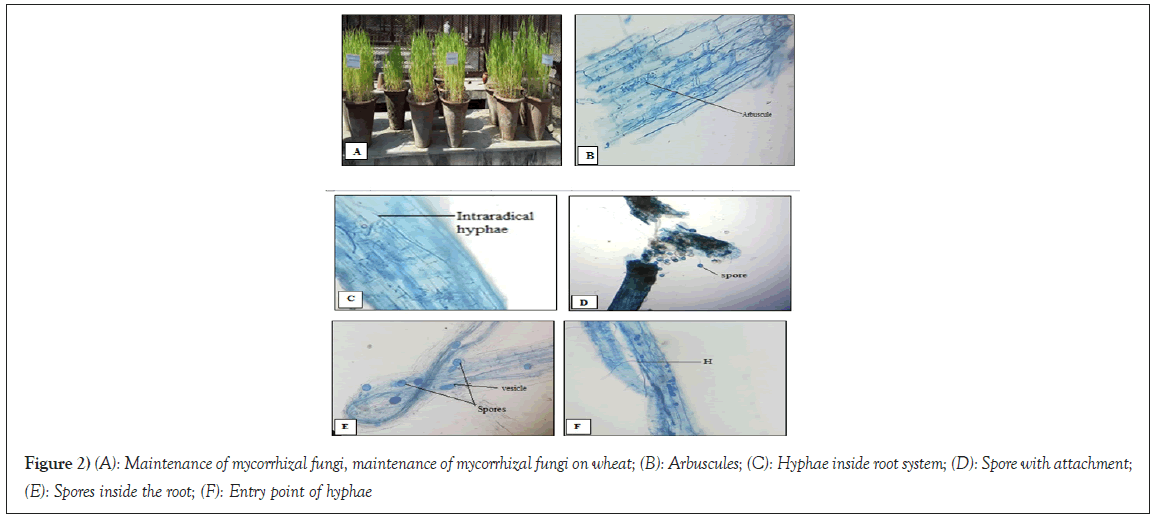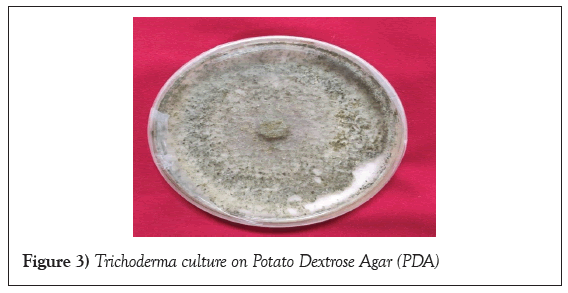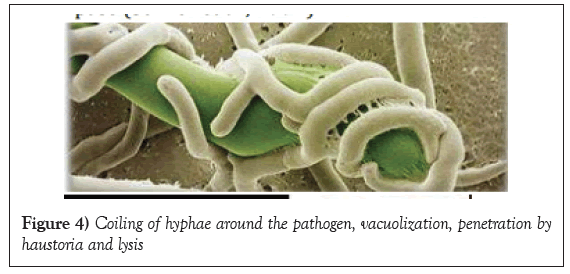Agricultural and Biological Research
RNI # 24/103/2012-R1
Research Article - (2024) Volume 40, Issue 2
Soil-borne diseases pose significant threats to crop yields and agricultural economies worldwide. Consequently, effective crop protection strategies are vital for sustaining agricultural productivity. Historically, the reliance on chemical fungicides has been prevalent to enhance crop yields. However, the indiscriminate use of these chemicals has led to detrimental effects on the environment, human health and overall ecosystem balance by unintentionally harming non-target organisms. In response to these challenges, alternative approaches have gained traction in recent years for managing soil-borne diseases. Among these alternatives, biocontrol emerges as a promising eco-friendly solution, mitigating the risks associated with chemical residues on human health and the environment. Biocontrol Agents (BCAs) offer a less toxic and more flexible alternative to chemical pesticides. These agents exert their effects through various mechanisms, including antibiosis, competition for resources, parasitism and the Induction of Systemic Resistance (ISR). Bacteria such as Bacillus spp., Pseudomonas spp. and fungi like Trichoderma spp. are widely recognized as effective bio-control agents against soilborne diseases. Notably, bacteria such as Bacillus spp. and Agrobacterium radiobacter thrive in soil and the rhizosphere, making them particularly suitable for agricultural applications. This review emphasizes the intricate interactions among soil-borne pathogens, their natural antagonists, plants and the environment, with a focus on fostering sustainable agricultural practices. However, successful implementation of biocontrol strategies requires appropriate management approaches tailored to specific agricultural ecosystems, ensuring their efficacy and sustainability in the long term.
Biocontrol; Systemic resistance; Rhizosphere; Ecosystem
Soil-borne pathogens are responsible for a decline in yield, quality of products; contaminate food grains and other economic parts of the plant with harmful toxic chemicals and causing great economic losses [1]. Pythium spp., Rhizoctonia spp., Fusarium spp., Phytophthora spp., Xanthomonas spp. and Pseudomonas spp. are the most common pathogens of soil affecting most of the crops and causing various diseases like root rot, leaf fall, wilting, damping-off, blight, canker, etc., in plants. Due to climate change these plant pathogens are becoming more aggressive, breaking the plant resistance to various germplasm and predominantly cultivated varieties and inhibit the crop to reach its optimum yield. The current practices for management of these diseases are mostly based on host plant resistance and synthetic chemicals. The continuous overuse of these chemicals like pesticides, insecticides, herbicides and fertilizers in agriculture for controlling diseases directly effect on the health of consumers, disturbing the food chain and food web, biomagnifications of chemicals and economic losses to any country by increasing the cost of food products and other side effect have raised a serious alarm [2,3]. Food grains are important for consumers and to prevent it from the contamination of chemicals, a new approach “biocontrol” has been used in agriculture. The Biocontrol Agents (BCAs) refer to the organism responsible for inhibiting or prevent the growth and development of other harmful pathogens. Some of plant growth-promoting rhizobacteria are studied and used in managing soil-borne diseases in plants as they reduce diseases by acting as biocontrol agents [4]. Biocontrol encompasses a diverse array of eco-friendly microbes, offering a rich source of biologically active compounds. These microbes have the remarkable ability to coexist in the environment as non-dominant species while effectively suppressing plant pathogens. Leveraging biological control serves as a sustainable approach to managing plant pathogens, fostering a deeper understanding of the intricate interactions among pathogens, plants and the environment in the pursuit of sustainable agriculture [5].
What are biocontrol agents?
The term ‘biocontrol’ have used in several areas of biology, especially in plant pathology and entomology. The biocontrol in which the living organism such as bacteria, fungi, nematode or predatory insect those suppresses the growth and development of other organism populations. The term biocontrol agents apply to the use of microbial antagonists which suppresses the growth of pathogens included mainly host-specific. The microbial antagonist that used to control the soil-borne plant diseases, by making bio-formulations called bio-pesticides. Bio-pesticides are eco-friendly approaches for the control of soil-borne pathogens in peanut by the mechanisms involved in their antagonistic activity (Figure 1).

Figure 1: Proposed model for a biocontrol research and development program.
Initially, a diverse array of microorganisms is gathered and subjected to screening for biocontrol efficacy. Numerous isolates undergo screening to pinpoint a disease-suppressive strain (illustrated as a yellow rod). However, it's improbable for this strain to exhibit effectiveness across various conditions. A strategy for identifying new strains that collectively demonstrate efficacy across diverse conditions involves unraveling biocontrol mechanisms and discovering additional biocontrol agents sharing these mechanisms. Genetic analyses can unveil biocontrol mechanisms, such as the role of antibiotic X in biocontrol mechanism. Understanding these mechanisms and the associated genes can facilitate the development of nucleic acid probes tailored to identify new strains with identical biocontrol mechanisms, as depicted by a probe for gene anfX. Despite sharing similar biocontrol mechanisms, strains harboring antX may exhibit genetic diversity in significant aspects. This diversity enables some new strains to be effective on different crops across various geographic regions or as part of genetically diverse mixtures. This approach facilitates the identification of extensive collections of disease-suppressive strains, bypassing the necessity to replicate the extensive research [6].
The function of prospective bio-control agents in management of soilborne pathogens
Soil-borne pathogens survive in soil as soil inhabitants and saprobes, widely distributed depend upon the cropping and production practices. Soil with poor irrigation facilitates allow the growth of several soil-borne pathogens which included mainly fungal pathogens like Phytophthora, Pythium while, Fusarium and Verticillium wilt occur more frequently in damp soils rather than in dry soils [7]. The usage of Plant Growth-Promoting Rhizobacteria (PGPR) as biocontrol agents, against the soil-borne fungal pathogens, is a complementary strategy [8,9]. The biocontrol provides by PGPR involves competition, parasitism, antibiosis, etc., which act as a natural process [10,11]. Pathogen suppression by PGPR occurs mainly by the activities involved in PGPR rapid growth, multiplication and survival [12]. Biocontrol agents contribute directly to plant growth by production of phytohormones like cytokines, gibberellins and auxin, increase nutrient uptake, siderophore and lytic enzyme production, induction of systemic acquired resistance and reduction the level of ethylene [13].
Mycorrhiza as biocontrol agents
Mycorrhiza is the most prevalent form of symbiotic relationship between plant roots and soil fungi. Symbiosis is so well balance that many of the host cells are invade by the fungal endophyte but there is no visible tissue damage and under certain conditions, it enhances the growth and vigor of the plant. The potential role of mycorrhizal fungi as biocontrol agent for the control of fungal plant diseases has recently received considerable attention [14]. Vesicular Arbuscular (VA)-mycorrhizal infection generally inhibits or sometimes increases and occasionally has no effect on diseases caused by fungal pathogens [15-18]. Arbuscular Mycorrhizal Fungi (AMF) represent a functionally important component of soil microbial community, being of particular significance for plant mineral nutrition in tropical agro ecosystems [19]. Bodker et al., [20] noted the effect of phosphate and the arbuscular mycorrhizal fungus G. intraradices on disease severity of root rot of pea. In Kerala wilt infested area of solanaceous crops, the mycorrhizal fungi (Glomus sp., Acaulospora sp. and Sclerocystis sp.) were the major species and were minimum in tomato and maximum in brinjal [21]. Dai et al., [22] has been reported that in chilli phosphorus content was highest at 150% of organic manure application. Significantly more phosphorus content was observed in mycorrhizal plants than the non-mycorrhizal plants. Oyetunji et al., [23] has been reported that plants inoculated with the G. mosseae has much thickened cell walls particularly at the edges as compare to uninoculated plants. G. mosseae and T. koningii inoculations, controlled Fusarium wilt of pepper. However, these were inoculated at least a week earlier then attack by the pathogen. Tomato roots inoculation with mycorrhizal fungus strains significantly influenced the number of tomato leaves and improved the health status of the plant (Figure 2) [24].

Figure 2: (A): Maintenance of mycorrhizal fungi, maintenance of mycorrhizal fungi on wheat; (B): Arbuscules; (C): Hyphae inside root system; (D): Spore with attachment; (E): Spores inside the root; (F): Entry point of hyphae.
Pseudomonas as biocontrol agents
The genus Pseudomonas belong to the category of non-spore forming, gram-negative and rod-shaped a natural biocontrol agent living in disease suppressive soils and can rapidly grow, colonize and survive in a highly competitive ecosystem for their survival included food and space. Many researchers have been found that fluorescent Pseudomonas strain represents antagonisitic activity against fungal pathogens and abundant in the rhizosphere of different crops. Pseudomonas putida WCS358r, are genetically engineered to produce the phenazine and 2,4-Diacetylphloroglucinol (DAPG), showed modified ability to suppress the plant diseases in wheat [25]. The strains of Pseudomonas can colonize in the root system of several crops, maintaining the control population densities in the rhizosphere [26]. Two isolates of Herbaspirillium spp. and Pseudomonas spp. produced volatile compounds having the potential to inhibit the growth of Fusarium oxysporum f. sp. cubense race 4. The identified compounds were methanethiol, 3-undecene and 2-pentene 3-methyl. Talc-based preparation of P. fluorescens when applied to soil@ 15 g/plant on banana significantly checked wilt disease [27]. The capability in P. fluorescens for suppressing Fusarium depends on its potential to produce antibiotic DAPG. DAPG obtained from P. fluorescens when applied to soil significantly inhibited spore germination and growth of F. oxysporum.
Application of Trichoderma for control of soil-borne pathogens
The most commonly used bio pesticide in living form namely Trichoderma spp. have been found effective in suppressing the soil-borne plant pathogens [28]. Trichoderma a genus was first proposed by Persoon 1794 in Germany and described it as fungi having mealy powder-like appearance enclosed by a hairy covering. Some species of the genus Trichoderma have been used as effective biocontrol agents against soil-borne, foliar and postharvest fungal pathogens in several plant crops, including peanut [29]. Trichoderma species such as T. viride and T. harzianum reduced the incidence of collar rot disease in groundnut caused by Aspergillus niger in a screen house study (Figure 3) [30].

Figure 3: Trichoderma culture on Potato Dextrose Agar (PDA).
The fungus occurs worldwide and is associated with plant roots, plant debris, temperate and tropical soils in 10¹-10³ culturable propagules per gram [31]. Trichoderma species have good agricultural importance due to antagonistic abilities against soil born plant pathogens by the mechanisms of antagonism: The production of antifungal metabolites, competition for space and nutrients, induction of defense responses in the plant, mycoparasitism, ability to promote plant growth such as increase plant height, leaf area, dry weight, stronger root growth, nutrient uptake and other yield attributes. Direct effects of Trichoderma on plant growth and development are significantly important for agricultural uses and for understanding the roles of Trichoderma in natural and managed ecosystems (Figure 4) [32-35].

Figure 4: Coiling of hyphae around the pathogen, vacuolization, penetration by haustoria and lysis.
Mechanisms of action of biocontrol agents
The biological control may have resulted from many different types of interactions among the organisms (Table 1). In the mechanism of biocontrol, the pathogens are antagonized by the presence and activities of antagonists. Direct antagonist results from the direct contact or highly selective for the pathogens expressed by the antagonists, while in case of indirect antagonisms results from the activities that do not directly target the pathogens. Many of the biocontrol agent viz. Trichoderma spp., Bacillus spp., Pseudomonas fluorescens and Agrobacterium radiobacter (K84) strain [36-38].
| Types | Mechanism | Examples |
|---|---|---|
| Direct antagonism | Hyperparasitism/predation | Lytic/some non-lytic mycovirus |
| Ampelomyces quisqualis | ||
| Lysobacter enzymogens | ||
| Pasteuria penetrans | ||
| Trichoderma virens | ||
| Mixed-path antagonism | Antibiotics | 2,4-diacetylphloroglucinol |
| Phenazines | ||
| Cyclic lipopeptides | ||
| Lytic enzymes | Chitinase | |
| Glucanases | ||
| Proteases | ||
| Unregulated waste products | Ammonia | |
| Carbon dioxide | ||
| Hydrogen cyanide | ||
| Physical/chemical interference | Blockage of soil pores | |
| Germination of signals consumption | ||
| Molecular cross-talk | ||
| Confused | ||
| Indirect antagonism | Competition | Exudates/leachates consumption |
| Siderophore scavenging | ||
| Physical niche occupation | ||
| Induction of host resistance | Contact with fungal cell walls | |
| Detection of pathogen-associated molecular patterns | ||
| Phytohormone-mediated induction |
Table 1: Progression of bacterial blight on clusterbean in relation to weather parameters epiphytotic conditions during Kharif 2023.
Antibiosis
Antibiosis is a biological interaction between microorganisms, in which the organic substance of low molecular weight produced by microorganisms that affect the metabolic activity and growth of other microbes. A variety of antibiotics have been identified, including compounds such as 2,4-Diacetylphloroglucinol (DAPG), amphisin, oomycin A, hydrogen cyanide, pyoluteorin, phenazine, tensin, pyrrolnitrin, cyclic lipopeptides and troplone produced by pseudomonads and kanosamine, oligomycin A, xanthobaccin and zwittermicin A produced by Streptomyces, Bacillus and Stenotrophomonas spp. (Table 2).
| Sources | Antibiotics | Plant diseases |
|---|---|---|
| Agrobacterium Radiobacter | Agrocin 84 | Crown gall |
| Bacillus amyloliquefaciens FZB42 | Bacilomycin, Fengycin | Wilt |
| Bacillus subtilis UW85 | Zwittermicin | Damping-off |
| B. subtilis QST713 | Iturin A | Damping-off |
| B. subtilis BBG100 | Mycosubtilin | Damping-off |
| P. fluorescens F113 | 2,4-diacetylphloro glucinol | Damping-off |
| P. fluorescens Pf-5 | Pyoluteorin, | Damping-off |
| Trichoderma virens | Gliotoxin | Root rot |
Table 2: Antibiotics producing bio-control agents against diseases.
Hyperparasitism
• The hyperparasitism means that the pathogens which are directly parasitized or attack with specific BCAs. Generally, mycoparsitism involves four steps:
• Chemotropic growth, where the biocontrol agent can grow toward the target fungus.
• The recognition includes specific interaction between lectin of pathogen or carbohydrates receptors on the biocontrol agent surface.
• Attachment by cell wall degradation such as chitinases and 1,3-glucanases.
• Penetration, where the biocontrol agent could produce a structure like appressoria for penetrating the cell wall of pathogenic fungus [39].
In some cases, multiple hyper parasites attack a single fungus such as Acremonium alternatum, Cladosporium oxysporum and Gliocladium virens can parasitize the powdery mildew fungi [40]. A classic example is the hypovirus, a hypoparasitic virus on Cryptonectria parasitica, a fungus causing chestnut blight. The hypovirulence of hypovirus reduces the diseases-producing capacity of C. parasitica [41].
Competition
Biocontrol agents and pathogens engage in competitive interactions for nutrients and space within the environment. This competition represents an indirect confrontation, wherein pathogens are excluded through resource depletion and physical occupation by biocontrol agents [42]. Filamentous fungi rely on iron uptake to regulate growth and metabolic processes. Under iron-deficient conditions, Trichoderma sp. produce siderophores, low molecular weight iron chelators, which sequester iron molecules, thereby inhibiting the growth of other fungi [43]. Additionally, carbon competition plays a significant role in suppressing Fusarium wilt, where non-pathogenic strains of F. oxysporum outcompete pathogenic ones [44]. This competition extends to the rhizosphere, where rhizobacteria effectively compete with Pythium ultimum for carbon sources, providing efficient biocontrol against seedling damping-off in various crops.
Advantages of biocontrol strategies
• Safety from hazards of chemicals.
• It can be used in organic form.
• Reduces the excessive use of pesticides.
• Reduces legal, environmental and public issues.
• Commercially available in the market.
• Environmental eco-friendly.
Disadvantages of biocontrol strategies
• Requires skilled and expertise.
• Time-consuming in disease control and does not achieve immediately.
• Take more intensive management and future planning.
• Peoples are not aware of this phenomenon.
Soil-borne plant diseases like wilt, damping-off, root rot and collar rot, etc. cause a hazardous impact on the yield loss in the agricultural and ornamental ecosystem. The soil-borne pathogens such as Rhizoctonia solani, Phytophthora, Pythium, Sclerotium rolfsii, Fusarium and Verticillium have a wide range of host and destroy many vegetables, ornamental and agricultural plants. In the past few years, the management of the soil-borne diseases was often based on the application of chemical mainly soil fumigants which was successful in managing the disease, but side effects of these chemicals on the environment, human and animals, turned into biggest diversified problems for whole ecosystem. Antagonistic bacteria and fungi are widely used to manage soil-borne diseases. In comparison with chemicals, biocontrol is a healthier and safer mechanism to control harmful pathogens and toxic microorganisms. Biocontrol agents also use as plant growth-promoting factors and biotic stimulation induce the Systemic Acquired Resistance (SAR) of plants against soil-borne pathogens. However, a better understanding of the factors involved and signaling interaction among antagonists and pathogens, soil and plants are yet revealed to promote the bio-control agents as wide applicable bio pesticides in a sustainable agricultural ecosystem.
[Crossref] [Google Scholar] [PubMed]
[Crossref] [Google Scholar] [PubMed]
[Crossref] [Google Scholar] [PubMed]
[Crossref] [Google Scholar] [PubMed]
[Crossref] [Google Scholar] [PubMed]
[Crossref] [Google Scholar] [PubMed]
[Crossref] [Google Scholar] [PubMed]
[Crossref] [Google Scholar] [PubMed]
[Crossref] [Google Scholar] [PubMed]
[Crossref] [Google Scholar] [PubMed]
[Crossref] [Google Scholar] [PubMed]
[Crossref] [Google Scholar] [PubMed]
[Crossref] [Google Scholar] [PubMed]
[Crossref] [Google Scholar] [PubMed]
[Crossref] [Google Scholar] [PubMed]
[Google Scholar] [PubMed]
[Crossref] [Google Scholar] [PubMed]
Citation: Sarita, Kumar S. Bio-control emerges as a novel and environmentally sustainable method for mitigating soil-borne plant pathogens. AGBIR.2024;40(2):1013-1017.
Received: 27-Feb-2024, Manuscript No. AGBIR-24-130158; , Pre QC No. AGBIR-24-130158 (PQ); Editor assigned: 29-Feb-2024, Pre QC No. AGBIR-24-130158 (PQ); Reviewed: 14-Mar-2024, QC No. AGBIR-24-130158; Revised: 21-Mar-2024, Manuscript No. AGBIR-24-130158 (R); Published: 28-Mar-2024, DOI: 10.35248/0970-1907.24.40.1013-1017
Copyright: This open-access article is distributed under the terms of the Creative Commons Attribution Non-Commercial License (CC BY-NC) (http:// creativecommons.org/licenses/by-nc/4.0/), which permits reuse, distribution and reproduction of the article, provided that the original work is properly cited and the reuse is restricted to noncommercial purposes. For commercial reuse, contact reprints@pulsus.com This is an open access article distributed under the terms of the Creative Commons Attribution License, which permits unrestricted use, distribution, and reproduction in any medium, provided the original work is properly cited.
